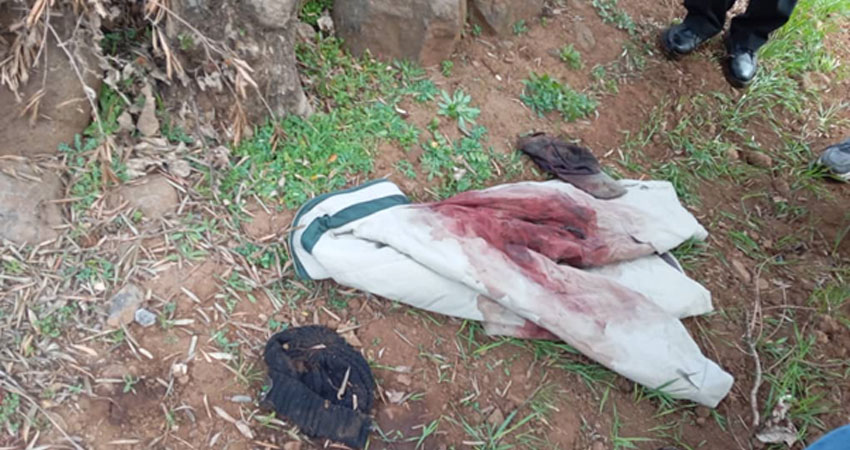Warning: The report contains violent images in the appendix.
Note: The report has been updated and new visual elements added on 8 May 2025.
-
Introduction
As part of its efforts to document ongoing human rights violations even after the fall of the Assad regime, Syrians for Truth and Justice (STJ) has verified the summary executions of at least 16 individuals in the predominantly Alawite village of Fahel, located northwest of Homs Governorate. These executions occurred during a “combing” campaign – essentially a raid and search – on 23 January 2025. Villagers believe the killings were motivated by “retaliation with clear sectarian intentions”.
The “combing” operation was part of a broader security campaign launched by the Syrian transitional government’s security forces in western rural Homs on 21 January 2025. The campaign aimed to track down remnants of the previous regime and smugglers in the area. It is also important to recall that Hay’at Tahrir al-Sham (HTS), along with other opposition factions led by Ahmed al-Sharaa, overthrew the al-Assad regime and took control of Damascus following Operation Deterrence of Aggression in December. HTS was later dissolved on 28 January 2025.
Among the 16 people who were summarily executed, 14 were members of the former Syrian Army, including at least four retired officers. Additionally, at least two of those executed had undergone status settlements at reconciliation centres established by the transitional government in Homs. According to witnesses, the other two victims were civilians who were taken off a bus heading to their village and executed after their Alawite affiliation was revealed during questioning.
Notably, witnesses interviewed by STJ for this report requested confidentiality due to fears of retaliation from security forces; thus, STJ used pseudonyms in their accounts.
The killing of the 14 Syrian Army soldiers was part of a larger incident involving 56 individuals, most of whom were civilians. These individuals were taken from their homes by the campaign’s initiators and brought to a square in an area locally known as al-Kazia. Of those taken, 35 were released immediately after ransoms were paid, while seven others were arrested and transferred to Homs Central Prison. These seven individuals were released five days later following protests organized by local villagers. Witnesses reported that the campaign involved heavy gunfire, looting of homes, and violent, humiliating treatment of residents during the searches.
Two witnesses confirmed allegations that violations in Fahel were committed by General Security forces and HTS-linked militias, which led the security campaign. However, Hamza Qablan, the director of public relations in Homs, attributed these violations to “criminal groups” that allegedly entered the village after the security forces had completed their operations and left, arresting individuals on specific lists. Qablan also mentioned that authorities arrested a group suspected of involvement in the killings, but provided no further information about this group.
This statement contradicts the testimony of Salim al-Sayyid, a resident of Fahel, who stated that Qablan’s claim regarding individuals entering after the security forces departed is “baseless” since the massacres occurred during the campaign when security forces were present.[1] The incident in Fahel was described as was against a military group of regime remnants who refused to surrender their weapons and were neutralized by the Military Operations Administration. However, the Al-Jumhuriya website reported that officials from General Security asserted that “[t]hose killed were unarmed and were arrested and executed outside the framework of the law.”
Additionally, two sources informed the website that the director of the Houla region told residents the deceased had not died as a result of clashes but had been executed. He emphasized that the factions already present in the Houla region were not responsible for the incident and that the group accountable for the violation was not affiliated with the HTS, noting that 15 members of this group had been arrested and would be referred to the judiciary.
Fahel was not the only village to experience violations during the extensive security campaign; the neighboring village of Marimeen, whose residents are Murshidi and Alawite, also suffered, witnessing the killing of two people on 23 January 2025. This incident occurred during a search operation marked by sectarian insults, hate speech, and the destruction of images of religious figures from the Murshidi sect. Witnesses from Marimeen reported that the raid was conducted by Individuals wearing General Security uniforms, accompanied by members of factions other than HTS, as stated in accounts shared with the Snack Syrian website. However, this account contradicts the official narrative, which claimed that the violations were perpetrated by a “criminal group” impersonating security personnel after the actual security forces withdrew from the village.
Based on the information in the report, STJ recommends that the Syrian transitional government grant families of victims access to the findings of its investigations. This includes conducting fair, public, and transparent trials for those responsible for the violations that occurred in Fahel on 23 January 2025. Additionally, the transitional government should reorganize its “combing/search” operations to ensure their legality and prevent the recurrence of violations, particularly extrajudicial killings of civilians, retired military personnel who have surrendered their weapons, those who have reached settlement agreements, and individuals wanted on warrants. This can be achieved by implementing robust oversight mechanisms to monitor the actions of law enforcement agencies, including the General Security.
It is important to recall that the Taldou village, located in the Houla region near Fahel, experienced a horrific massacre in May 2012, during which 108 people, including 49 children, lost their lives. This tragic event was carried out by former Syrian government forces, including irregular armed groups known as “shabiha.” The then government claimed that “terrorist groups” were responsible for the massacre.
To read the full report in PDF format, click here.
[1] During an online interview conducted by an STJ researcher on 22 February 2025.

